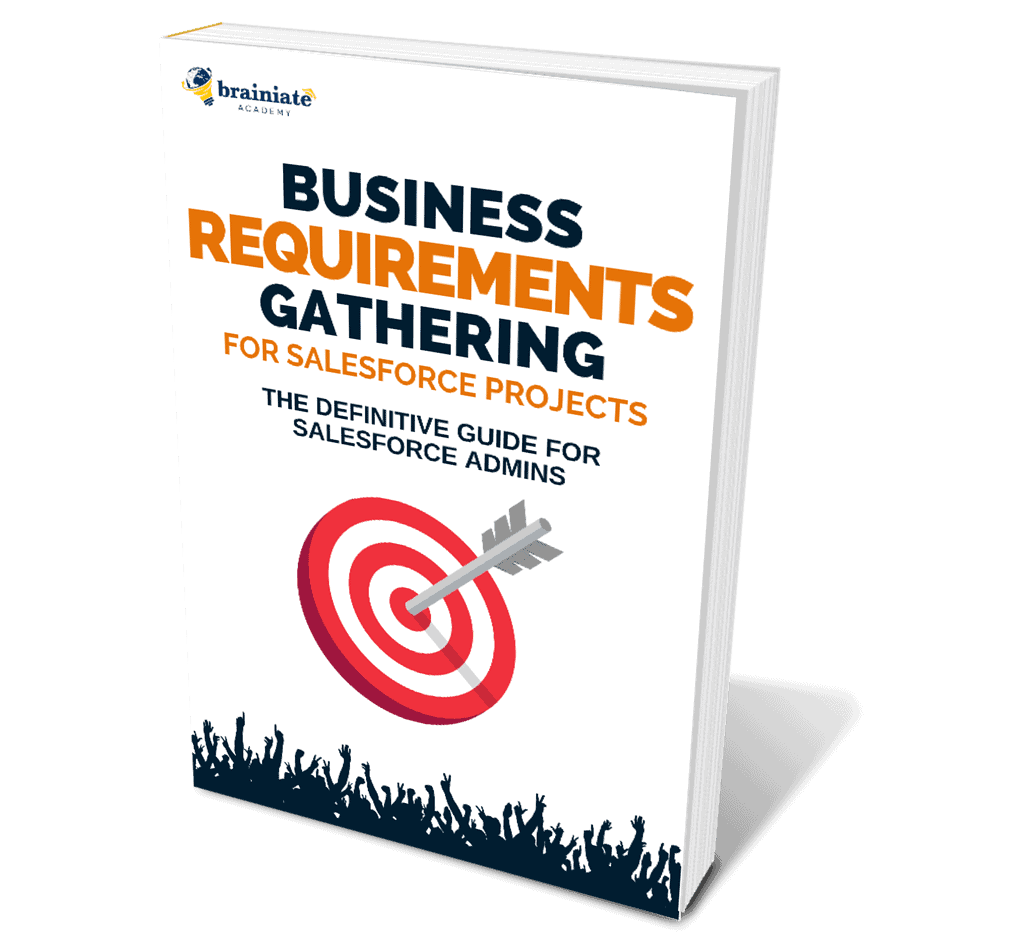What Is Business Requirements Gathering and Why It’s Important

If you’re a Salesforce Admin, you know the key to successful implementations and projects is gathering the correct business requirements. Without adequately understanding what your stakeholders need, no project can be successful—no matter how much time or money you invest.
But let’s face it—gathering business requirements isn’t always fun or glamorous.
It takes too long, requires digging into details, and sometimes seems unnecessary!
However, as we all know deep down inside (and as we’ll dive deeper into today!), having those details up front saves us tons of time in the long run and ensures everyone is on the same page from day one.
So roll up your sleeves, and let’s dig in because today, we are discussing the critical role of gathering business requirements for any Salesforce project!
Overview of Business Requirements
Business requirements are the driving force behind any Salesforce project, acting as a roadmap to ensure desired results and objectives are met. Each specific need or feature must be carefully assessed to guarantee the successful implementation of your system.
Understanding Business Requirements
To understand what your business requires from Salesforce, you must have a comprehensive list of all the needed features and capabilities. Understanding the business requirements of your stakeholders will help you develop a clear scope of work and set realistic expectations for stakeholders throughout the project. It also allows you to minimize risk by eliminating any potential surprises along the way.
Identifying Business Requirements
Identifying business requirements starts with understanding your stakeholder’s pain points and how they use your current Salesforce system (or want to use it in the future). Identifying business requirements helps you determine what areas need improvement and where there are opportunities for additional customization or automation. Additionally, it is essential to consider any legal or regulatory obligations that could impact your project when creating business requirements.
Benefits of Having Clear Business Requirements
Having clearly defined business requirements ensure that everyone understands what needs to be done during each project stage and reduces the potential for scope creep. It also helps ensure smoother communication between teams and more efficient resource allocation by allowing key stakeholders to focus on tasks that directly align with their skillset and expertise. Finally, having well-defined requirements can help mitigate risks associated with implementing new solutions or technologies by outlining expected outcomes in advance.
Developing precise business requirements is essential for ensuring successful implementations in Salesforce projects. By understanding stakeholders’ needs, identifying key objectives, and outlining specific features and capabilities required, businesses can ensure their projects are completed efficiently while meeting expectations at every stage of development.
DOWNLOAD YOUR COPY!

The quick-start guide to gathering business requirements
Are you responsible for ensuring Salesforce projects run as smoothly as possible?
With the Business Requirements Gathering for Salesforce Projects: The Definitive Guide for Salesforce Admins, you can quickly get up to speed on the best practices for gathering business requirements.
This comprehensive book, written by Salesforce consultant and trainer David Giller, provides powerful methods and insights to ensure your projects are successful.
Why Clear Business Requirements Are Essential for Salesforce Success
Understanding the importance of having precise business requirements is critical to successfully managing a Salesforce project. Having these in place can help ensure that the stakeholder’s expectations are met and that budget, time, and resources are used wisely.
Here are some of the reasons why precise business requirements are so necessary:
Defining Objectives
Having precise business requirements provides a roadmap for the project by defining objectives, timelines, and use cases. It also helps determine what features must be included to meet stakeholder needs and expectations and which should be prioritized.
Managing Risk
Having a detailed set of business requirements also helps manage risk and provides insight into potential problems or conflicts during the project. Managing risk in your Salesforce project allows project managers to proactively address issues before they become costly mistakes or delays.
Streamlining Processes
Precise business requirements help streamline processes by setting concrete boundaries around the scope and timeline of tasks, eliminating guesswork or confusion. Streamlining your business processes makes assigning tasks and responsibilities easier, measuring progress, and tracking expenses.
Improving Communication
Having well-defined goals helps keep everyone on the same page while ensuring consistency throughout the project lifecycle. Precise business requirements lead to better communication between stakeholders and stakeholders because everyone knows what to expect from each other at every stage of development. Improving communication minimizes misunderstandings, reduces time spent reworking projects, and enhances efficiency overall.
In summary, precise business requirements are essential for success in any Salesforce project because they define objectives, manage risk, streamline processes, and improve communication between all parties involved to ensure ultimate success.
🔥 SUBSCRIBE! 🔥

Get practical Salesforce advice in your inbox!
Feeling overwhelmed by everything you have to do as a Salesforce Admin?
I know how it feels.
I created the FREE Brainiate Newsletter – to help you stay up-to-date with the latest Salesforce news, advice, and product recommendations.
Sign up for my newsletter and get all that information right in your inbox – without having to search for it yourself. You’ll be able to focus on your projects with peace of mind, knowing you’re always up-to-date on the latest Salesforce updates.
Click the button below and sign up for my FREE Brainiate Newsletter today!

Gathering Accurate Business Requirements for a Salesforce Project
Any Salesforce project’s first and most crucial step is gathering accurate business requirements. By clearly understanding what the stakeholder wants, teams can avoid costly mistakes and ensure their efforts focus on the right tasks. Here are some tips to help you gather accurate business requirements:
1. Establish Trust
Establishing trust between all stakeholders is essential to gathering accurate business requirements. When stakeholders feel comfortable sharing details about their needs and objectives, they’re likelier to be open and honest about them. Forming a trusting relationship with stakeholders will also make it easier for you to ask questions and gain further clarity about specific requirements.
2. Clarify Objectives
A solid understanding of the stakeholder’s objectives is essential for gathering accurate business requirements. Have the stakeholder explain their project goals for success. Ask questions about inconsistencies or ambiguities in their objectives. Defining the objectives will ensure your team understands the ultimate goal to achieve.
3. Break Down the Requirements
Break down large, complex projects into smaller parts to make them easier to process and manage. Ask stakeholders to prioritize each piece based on its importance, so you can focus your energies in the right place first before tackling other elements later on. Once broken down into individual components, you can start discussing each part in detail, ensuring that everyone understands what is required of them throughout the project lifecycle.
4. Document Everything
Finally, remember to document everything from conversations with stakeholders to decisions made by stakeholders throughout the project lifecycle. An easily accessible record of these exchanges will be invaluable when revisiting conversations or troubleshooting issues later in the project’s development stage. Taking good notes will also save time by allowing you to refer back quickly instead of re-creating documents from scratch whenever something changes or needs updating during the development or deployment stages.
FREE EMAIL TEMPLATES

Free email templates for Salesforce admins
These FREE email templates can supercharge your productivity and efficiency as a Salesforce Admin. They cover various topics, such as getting information about a new user, territory redeployment, importing data, and following up on report requests.
Whether you need to save time on admin tasks or improve your team’s communication, these templates will help you get the job done.
Plus, they’re 100% customizable, so you can easily tailor them to your needs.
So what are you waiting for? Get started today and see the results for yourself!
Types of Business Requirements for a Salesforce Project
Understanding business requirements is essential for any successful Salesforce project. Here are some of the critical areas to consider:
Project Scope
It’s essential to identify and define the project’s scope, including what specific objectives need to be achieved and any applicable constraints or limitations. The project scope helps you to ensure that all stakeholders are on the same page and can stay focused on accomplishing the intended goals.
Operational Requirements
To ensure project success, it’s vital to thoroughly comprehend the organization’s operations and pinpoint processes or systems expected to be managed in Salesforce. Establishing these details beforehand provides an essential blueprint for delivering optimum results.
User Requirements
Identifying user requirements involves understanding who will use the system, their roles and responsibilities, how they interact with it (including any existing user interfaces), and their expectations. User requirements help establish clear expectations from both sides so that users can gain maximum value from their experience with Salesforce.
Data Requirements
Data requirements involve considering what data needs to be stored and how it should be organized within Salesforce. It’s essential to understand which data points are necessary to capture critical information about products, stakeholders, orders, etc., to make the right real-time decisions.
Technical Requirements
When managing a Salesforce project, we must be keenly aware of all the technical requirements and expectations of the business to guarantee appropriate security protocols and policies, scalability, and reliability meet expectations, and integration capabilities with other systems prove functional. Considering all these factors is essential for delivering an efficient deployment experience.
Business Requirements and Adaptability
Business requirements are the needs of a company to achieve specific objectives. They can be influenced by internal or external factors, meaning they may change or evolve. Adapting to changing business requirements is critical to the success of Salesforce projects, as it allows organizations to respond quickly and effectively to new challenges.
Why Business Requirements Change
Business requirements can change for many reasons, including changes in stakeholder needs, shifts in organizational direction, and technological advances. Organizations need to remain agile to stay ahead of their competition, and organizations can stay competitive and ensure long-term success by responding quickly to changing business requirements.
Advantages of Adaptability
Adaptability gives Salesforce projects an advantage over those that don’t consider changing business requirements. Being adaptable allows organizations to keep up with rapid technological advancements and changes in stakeholder preferences while staying ahead of their competition. Additionally, adaptability ensures that organizations can provide the best possible services to their stakeholders, which leads to improved stakeholder satisfaction and loyalty.
How To Adapt To Changing Requirements
- Understand Your Organization: Take time to understand your organization’s core objectives, values, and priorities so that you can adjust when needed.
- Learn From Mistakes: Learn from previous mistakes so that similar errors don’t occur again.
- Stay Up-To-Date On Trends: Monitor trends related to your industry so that you can anticipate potential changes before they happen.
- Listen To Feedback: Actively listen to feedback from stakeholders and stakeholders, as this will help you identify any areas where improvements need to be made for your project to stay competitive.
- Collaborate With Others: Collaborate with other teams within your organization to better understand how changes on one side may affect another team’s workflows.
By taking the above steps, organizations will be better prepared for future changes or challenges during a Salesforce project, allowing them increased adaptability without compromising quality or efficiency.
Gaps in Business Requirements
For Salesforce projects, gaps in business requirements can be critical. Building an effective, efficient solution without the correct information is challenging. In addition to increasing costs, inadequate planning can decrease user satisfaction and project delays. Fortunately, there are ways to identify and address these issues.
Identifying Gaps
The first step towards dealing with gaps in business requirements is to recognize when there may be a problem. You can identify gaps by carefully analyzing the stakeholders’ expectations and reviewing existing documentation and processes. During this stage, project teams should also consider collecting feedback from end users who will interact with the system. Doing so allows them to gain insight into which features are most important and where potential problems may arise.
Addressing Gaps
Once gaps have been identified, project teams should work together to determine how best to address them. One approach is for the stakeholders and technical team members to hold brainstorming sessions that allow everyone involved to express their opinions and ideas on how best to move forward. During these meetings, all participants must respect each other’s ideas and perspectives for new solutions to emerge from the conversation.
Additionally, Salesforce provides resources to help teams devise solutions for any gaps discovered during the review process. These include online courses covering topics such as customizing objects, creating formulas, and generating reports – all of which provide helpful guidance when building a successful system structure. Official Salesforce partners also specialize in providing expert advice on implementing projects using the platform’s tools and features.
Finally, project teams may benefit from utilizing gap analysis templates that outline specific areas of concern within their projects, allowing them to track progress against an established set of criteria over time. Using these tools during the development cycles, they can quickly identify issues while ensuring everyone is working towards meeting their business objectives collectively rather than making assumptions based on individual preferences or agendas.
Gaps in business requirements on a Salesforce project can have severe consequences if left unchecked – from increased costs due to rework or downtime caused by unforeseen issues arising during deployment stages; down to user dissatisfaction stemming from misunderstanding or miscommunication about expectations for functionality or output. By taking a proactive approach, however, teams can ensure that their projects remain on course by identifying potential problem areas early on, coming up with viable solutions, and leveraging industry-specific resources. Organizations can confidently launch successful systems with diligent effort, even when faced with challenging requirements.
Conclusion
In conclusion, making well-defined business requirements is fundamental during any Salesforce project. Although they can vary over time and become quite complex, it is essential to recognize their necessity and take the time to build precise business requirements. This can be reaching out to those affected by the implementation of your project, using online surveys, or interviewing stakeholders within your organization.
Business Requirements will allow for a more successful project outcome as you know exactly what you expect from the design and build process. Don’t let gaps in your current requirements stop you from continuing; you can always fill these in as the system evolves. For anyone looking to ensure their Salesforce initiative is a success, ensure that your business requirements are detailed so that nothing slips through the cracks!






